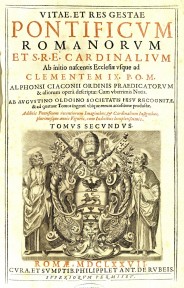
Portrait and Coat of Arms of Boniface VIII
The portrait and arms of Boniface VIII are drawn from the most important edition of the Lives of Roman Popes by Spanish Dominican friar Alfonso Chacón, published in Rome in four in-folio volumes in 1677. This was an illustrated edition, enhanced with several copper-plate engravings. Chacón was a historian, philologist and scholar who was called to Rome by Pius V in October 1566, as a penitentiary in St Peter's basilica. His unfinished work was completed by Francisco Morales Cabrera with the lives of the popes from Alexander VI to Clement VII and eventually published in 1601. A major success, the Lives was reprinted several times, with the addition of biographies of later popes, compiled by Andrea Vittorelli, Ferdinando Ughelli, Girolamo Aleandro, Luke Wadding, Cesare Becilli. A revision was published by Augustino Oldoini in 1677, with a supplement on Pope Clement IX. Two more volumes were finally published in 1751 by Mario Guarnacci, including all popes up to Clement XII.
Alfonso Chacón, Vitae, et res gestae pontificum Romanorum et s.r.e. cardinalium ab initio nascentis Ecclesiae vsque ad Clementem IX P.O. M. ..., vol. II, Roma 1677